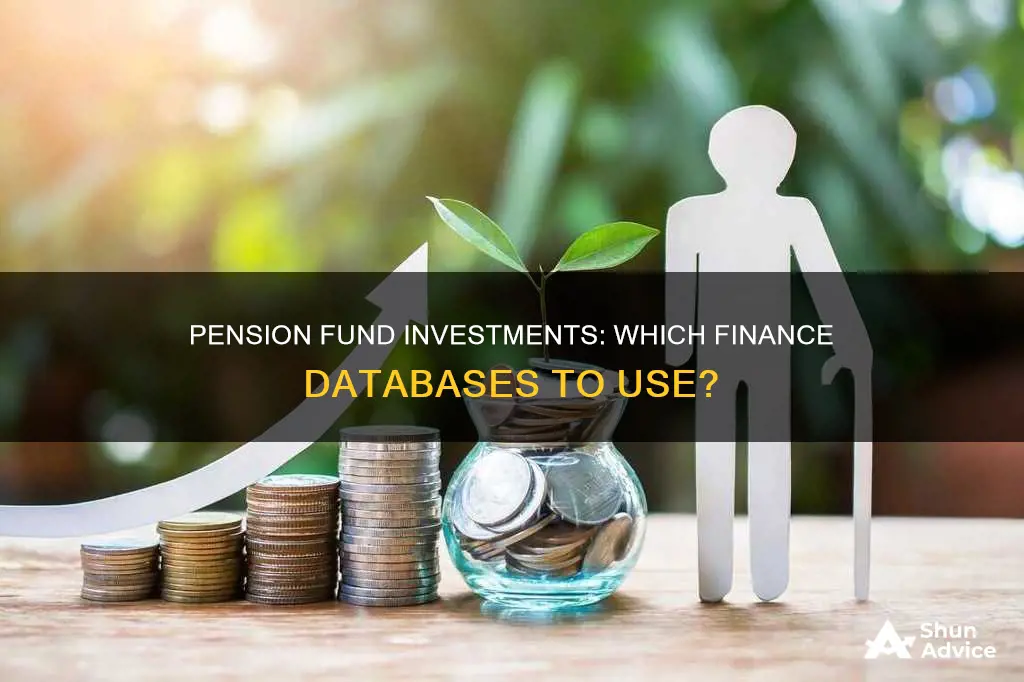
Pension fund investments are a crucial aspect of retirement planning, and several finance databases offer insights into this area. These databases provide valuable information on the performance, asset allocation, and trends of pension funds, helping investors make informed decisions. Public Plans Data, for instance, offers comprehensive details on state and local pension plans, including financial reports, actuarial data, and pension cost data. Similarly, Pensions & Investments provide Excel databases with information on firms managing, record-keeping, and advising on U.S. institutional, tax-exempt assets. The Office for National Statistics in the UK also maintains datasets related to investments, pensions, and trusts, offering insights into funded occupational pension schemes. These databases are essential tools for understanding the complex world of pension fund investments and their impact on individuals' financial futures.
What You'll Learn

Pension fund investments in the US
Pension funds in the US have traditionally invested in stocks and bonds, but in recent years, they have started to diversify their portfolios by investing in other asset classes such as private equity, real estate, infrastructure, and securities like gold. This shift in investment strategy is driven by the need to maintain a sufficiently high rate of return and adapt to changing market conditions.
In the US, pension funds are regulated by The Employee Retirement Income Security Act of 1974 (ERISA) and, more recently, The Pension Protection Act (PPA) of 2006, which introduced new funding requirements and rules for calculating assets and liabilities. According to the US Census Bureau, there are over 5,000 public sector retirement systems, with approximately 300 state-administered plans and 5,000 locally-administered plans. These plans collectively hold $5.3 trillion in assets and serve 14.9 million active members and 12 million retirees.
Pension funds in the US have a significant impact on the stock market due to their large investments in listed and private companies. They are also a major source of capital for the private equity industry. As of the second quarter of 2024, public and private-sector pension plans in the US managed a massive $40 trillion in assets.
Pension fund assets are prudently managed to ensure that retirees receive their promised benefits. This involves investing in a variety of asset classes while considering the fund's risk tolerance, projected stream of benefit payments, expected contributions, and long-term investment goals.
Pension funds in the US have also shown an increasing interest in passive investment methods, such as investing in index funds and exchange-traded funds (ETFs) that replicate market indices. Additionally, they are diversifying into alternative assets like commodities, high-yield bonds, hedge funds, and real estate.
Overall, pension fund investments in the US have evolved to adapt to changing market conditions and maintain the financial stability needed to fulfill their retirement income obligations.
Smart Mutual Fund Investment Strategies for Your 1 Crore
You may want to see also

Pension fund investments in the UK
The UK government has recognised the importance of pension fund investments and has implemented reforms to boost the economy, support British businesses, and improve returns for savers. These reforms include requirements for Defined Contribution (DC) pension funds to publicly disclose their investment levels in the UK, allowing employers and savers to make informed choices when comparing different schemes. The government's initiatives aim to increase transparency and consolidate the pensions market.
The Financial Survey of Pension Schemes (FSPS) provides valuable insights into the world of pension fund investments in the UK. It offers data on membership, contributions, benefits, assets, and liabilities of funded occupational pension schemes. This information helps track the performance and health of pension funds over time.
Public pension funds in the UK are invested in broadly diversified portfolios to generate investment earnings while managing risk. These investments are made with a long-term focus, considering factors such as risk tolerance, projected benefit streams, and expected contributions. The diversification of investments aims to optimise risk and return for pension funds.
Additionally, there are various databases and resources available that provide information on pension fund investments. These include the Public Plans Data, which offers comprehensive data on state and local pension plans, and Pensions & Investments (P&I), which provides Excel databases with details on US institutional, tax-exempt assets, and pension plans.
Mutual Funds in India: Invest Without a Broker
You may want to see also

Pension fund investments in real estate
Pension funds have been investing in real estate for decades, and it is a fundamental component of a diversified investment portfolio. Real estate investments offer stable and consistent income, the opportunity for capital appreciation, and inflation protection.
Pension funds have approximately $900 billion invested in real estate, with commercial real estate being the third-largest asset class in the United States. Real estate investments can take the form of equity or debt and can be accessed through private market structures, such as direct property investment or private commingled funds, or through public market investment structures, such as real estate investment trusts (REITs) listed on stock exchanges or funds that invest in REIT securities.
REITs are a popular choice for pension fund investments in real estate as they provide access to a diverse range of property sectors, including traditional sectors like office, retail, and industrial properties, as well as new economy sectors like infrastructure, data centres, and networked logistics properties. REITs also offer higher liquidity compared to other real estate investments, allowing investors to efficiently act on property type or geographic convictions and capitalise on market opportunities.
In addition to REITs, pension funds may also choose to invest in commercial mortgage-backed securities (CMBS), which are similar to bonds and are securitized by commercial real estate notes on Class A real estate. However, the pandemic negatively impacted CMBS as the sector saw significant loan defaults.
Some pension funds opt for a more hands-on approach by running real estate development departments that participate directly in the acquisition, development, or management of properties. These investments are typically long-term and focus on commercial real estate, such as office buildings, industrial parks, apartments, or retail complexes.
Overall, real estate investments play a crucial role in pension fund portfolios, offering stable income, capital appreciation potential, and diversification benefits.
Setting Up a Small Investment Fund: A Beginner's Guide
You may want to see also

Pension fund investments in private equity
However, with inflation on the rise, there is a growing argument that pension funds and their trustees should consider investments with higher returns, such as private equity, which typically offers returns between 15% and 20%. A report by the American Investment Council found that US public pension funds generated an annualised return of more than 12% from their private equity investments between 2010 and 2020, making it the best-returning asset class for public pension portfolios.
In contrast, the assets that UK pension funds have traditionally targeted are becoming increasingly expensive, and there is a risk that they will continue to deliver negative real returns. This makes a strong case for pension funds to consider private equity as a way to access better returns and boost the UK economy and entrepreneurial sectors. The Government is already exploring regulatory changes to encourage pension schemes to invest in long-term, illiquid assets, and trustees and advisors will need to embrace higher-risk, higher-return options.
For example, defined benefit (DB) schemes with viable sponsors could focus on optimising returns and cash flows through a more diversified portfolio that includes alternative assets, while still ensuring that pension obligations are met. This would allow pension schemes to benefit from private capital and PE investments, and facilitate a partnership between pension schemes and PE that could fuel UK economic growth.
Overall, while pension fund investments in private equity may involve higher risk, the potential for higher returns and the positive impact on the economy make it a worthwhile consideration for pension funds and trustees.
Finding Mutual Fund Managers: Where Do They Invest?
You may want to see also

Pension fund investments in infrastructure
Pension fund investment in infrastructure is the investment by pension funds directly in the non-traditional asset class of infrastructure assets as part of their investment strategy. Traditionally, pension funds have invested mostly in "core assets" such as money market instruments, government bonds, and large-cap equity, and, to a lesser degree, in "alternative assets" such as real estate, private equity, and hedge funds. The average allocation to infrastructure has historically represented only 1% of total assets under management by pensions, excluding indirect investment through ownership of stocks of listed utility and infrastructure companies.
However, government disengagement from costly long-term financial commitments to large infrastructure projects following the 2008–2012 global recession, combined with the realization that infrastructure could be an ideal asset class, has led to an increasing number of pension executives considering investing in infrastructure. This macro-financial perspective on pension investment in infrastructure was developed by US, Canadian, and European financial economics and labor law experts, notably from Harvard Law School, the World Pensions Council, and the OECD.
Pension funds, including superannuation schemes, account for approximately 40% of all investors in the infrastructure asset class, excluding projects directly funded and developed by governments, municipalities, and public authorities. Large Canadian pension funds and sovereign investors have been particularly active in energy assets such as natural gas and natural gas infrastructure, where they have become major players in recent years.
In the UK, the government unveiled a plan in 2011 to encourage large-scale pension investments in roads, hospitals, airports, and other infrastructure across the country. The plan aimed to attract £20 billion ($30.97 billion) of investment in domestic infrastructure projects over the next decade. On October 18, 2012, HM Treasury announced that the National Association of Pension Funds (NAPF) and the Pension Protection Fund (PPF) had succeeded in securing a critical mass of founding investors for the Pension Infrastructure Platform (PIP).
Public pension funds are invested in broadly diversified portfolios to generate investment earnings with an acceptable level of risk. Public pensions develop target asset allocations considering various factors, including the fund's risk tolerance, projected stream of benefit payments, expected contributions, and the efficient frontier, which optimizes levels of risk and return. The long-term nature of public pension fund investment goals allows investors to focus on long-term results within the context of the risk the fund incurs.
Infrastructure Funds: Where to Invest and How
You may want to see also
Frequently asked questions
Some finance databases that offer information on pension fund investments include:
- Public Plans Data: offers an interactive data browser with data on pension plan and pension cost data for each state.
- Office for National Statistics: provides data on funded occupational pension schemes in the UK, including information on membership, contributions, benefits, and assets.
- Pensions & Investments: offers Excel databases with information on firms managing, record-keeping, or advising on U.S. institutional, tax-exempt assets.
- Investment Company Institute: provides information on the $40 trillion in assets managed by public and private-sector pension plans in the U.S. in Q2 2024.
Pension funds have traditionally invested primarily in stocks and bonds, using a liability-matching strategy. However, in recent years, they have expanded their investments to include a wider range of asset classes, such as private equity, real estate, infrastructure, and inflation-hedging securities like gold.
A pension fund, or pension plan, is a retirement plan where an employer contributes to a pool of funds set aside for an employee's future benefit. The pool is invested on the employee's behalf, and the capital gains and earnings are used to generate income for the employee upon retirement.
Pension fund assets must be prudently managed to ensure that retirees receive their promised retirement benefits. This involves balancing the need for conservative, low-risk investments with the goal of achieving sufficient returns to cover promised benefits.







